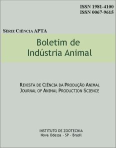Degradability of dry matter and crude protein of dry grains and wet grain silages from different processing corn hybrids (Zea mays)
DOI:
https://doi.org/10.17523/bia.v70n3p269Keywords:
high moisture grain, ruminal degradability, particle size, nutritive valueAbstract
The objective of this work was to evaluate the effect of processing two corn hybrids conserved, dry and humid grains, the dry matter (DM) and crude protein (CP) degradability in situ. The particle size was determined and difference was verified in MGD (Medium Geometric Diameter) of processed ingredients. Three sheep were used with rumen canulated, in a completely randomized design, using a factorial outline 2 x 2 x 3, being two corn hybrid, two conservation methods and three processing forms (whole, coarsely and finely ground), with five times of incubation (3, 6, 12, 24 and 48 hours). The fraction A in SDC (silage of dent corn) of DM was superior to GDC (grain of dent corn) in all of the particles size. The ensiling process increased the DM solubility, reducing the fraction B in comparison to dry grain. The values regarding the fractions DP and DE the 5% per hour of the protein, were larger for SDC and GDC, it presents a decreasing when the incubation time advances. The fermentation rate was superior for SDC and GDC. The ensiling process has positive effect in the decreasing of DM and CP in comparison to GDC.Downloads
Downloads
Published
Issue
Section
License
Os autores não serão remunerados pela publicação de trabalhos, pois devem abrir mão de seus direitos autorais em favor deste periódico. Por outro lado, os autores ficam autorizados a publicar seus artigos, simultaneamente, em repositórios da instituição de sua origem, desde que citada a fonte da publicação original seja Boletim de Indústria Animal. A revista se reserva o direito de efetuar, nos originais, alterações de ordem normativa, ortográfica e gramatical, com vistas a manter o padrão culto da língua e a credibilidade do veículo. Respeitará, no entanto, o estilo de escrever dos autores. Alterações, correções ou sugestões de ordem conceitual serão encaminhadas aos autores, quando necessário. Nesses casos, os artigos, depois de adequados, deverão ser submetidos a nova apreciação. As opiniões emitidas pelos autores dos artigos são de sua exclusiva responsabilidade. Todo o conteúdo deste periódico, exceto onde está identificado, está licenciado sob a Licença Creative Commons Attribution (CC-BY-NC). A condição BY implica que os licenciados podem copiar, distribuir, exibir e executar a obra e fazer trabalhos derivados com base em que só se dão o autor ou licenciante os créditos na forma especificada por estes. A cláusula NC significa que os licenciados podem copiar, distribuir, exibir e executar a obra e fazer trabalhos derivados com base apenas para fins não comerciais.













